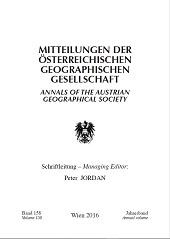
Mitteilungen der Österreichischen Geographischen Gesellschaft Band 158/2016, pp. 133-148, 2019/05/27
158. Jg. (Jahresband), Wien 2016

This paper analyses the potential factors underlying the different socio-economic paths of European countries after the Second World War. It is clear that divergent economic growth and increasing social and economic divides are still present not only between European Union (EU) and non-EU countries, but also inside these groups. Based on values of the Global Competitiveness Index (GCI), this paper deals with three clearly differentiated groups of European countries. These groups have divergent socio-economic development not only in the past, but still at the beginning of the 21st century. This is emphasised by the digital divide. The main economic and demographic indicators have been analysed, and they reveal that divergence in global economic competitiveness of European countries can be explained by different historical heritages, economic policies, and institutional structures. Although it is difficult to draw a strict line between the three groups, the rising “Chinese wall” is further expanding by the changing in the countries’ productivity, foreign direct investment structure, labour force, and demographics (population ageing, old dependency ratios, migration flows).
Keywords: Wirtschaftswachstum, Entwicklungsmodelle, sozio-ökonomische Konvergenz, Europäische Union